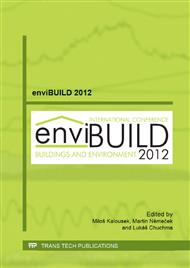[2]
Fig.4 : The Sun position and shadowing on 1st June at noon, a look at east and south facade [2] Fig.5: The course of measured temperatures at selected areas of the building and the exterior during the hottest days in 2010 [2] It was possible to generalize the influences on indoor climate in summer time (with a given system of forced ventilation) by the analyses of calibrated simulation model: · Solar gains control – shadowing, exterior blinds: the most important, · Solar gains control – type of glazing: important, · Accumulation core – floor, less important, · Accumulation core – internal surfaces of external walls: less important · Accumulation core – internal wall: little important, · Type of thermal insulation -(volume weight, thermal capacity):little important. The real construction influence on the quality of an envelope construction of wood-based building To state an impact of non-homogeneity of the envelope structures of the buildings in question we used thermovisual diagnostics. The aim was to localize thermal bridges and connections details which worsen thermal and technical attributes of the construction. Out of the number of thermovisual measurements there are mentioned two illustrative examples: · A significant thermal bridge caused by insufficient insulation of foundation detail and an issue of airtightness in the place of connection the wall with the base slab (Fig.6), · Thermal bridge of the construction which causes low surface temperature, decreases thermal comfort in the room and increases a risk of mould formation and condensation (Fig.7). Fig. 6: Thermovisual diagnosis of north facade of the building in question [2] Fig. 7: Low surface temperature in the place of thermal connection of the construction Airtightness measurements at the buildings in question by Blower door test showed defections which significantly raised the value of air Exchange intensity. Creation of Airtightness in the envelope of wood- based buildings is difficult and demanding for projection preparation and execution of individual construction connections details. At measurements the most common defections and airtightness breakings were showed in the critical details demonstrated by the examples: · breakage of vapour barrier by the installation workers and omitting airtight cup (cuffs) designed for cable protection device, · entering o air through the doors of chimney system or installation openings, · insufficient sealing of piping passage through airtight layer · unsuitable installation and construction design of loft hatch from the airtightness point of view (Fig.8) Fig. 8: Air flow through attic opening at normal presssure difference and at forced negative pressure of 50 Pa Literature sources:
Google Scholar
[1]
Isover (2008): Building Physics Training Docs, Thermal Comfort, Isover (2008)
Google Scholar
[2]
BEBEJ, D. (2012): Optimization of non-transparent external vertical wood based constructions suitable for energy passive buildings: dissertation PhD thesis. Zvolen: Technical university in Zvolen, (2012)
Google Scholar


